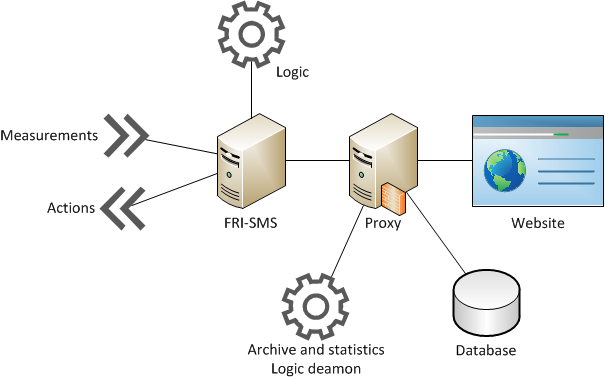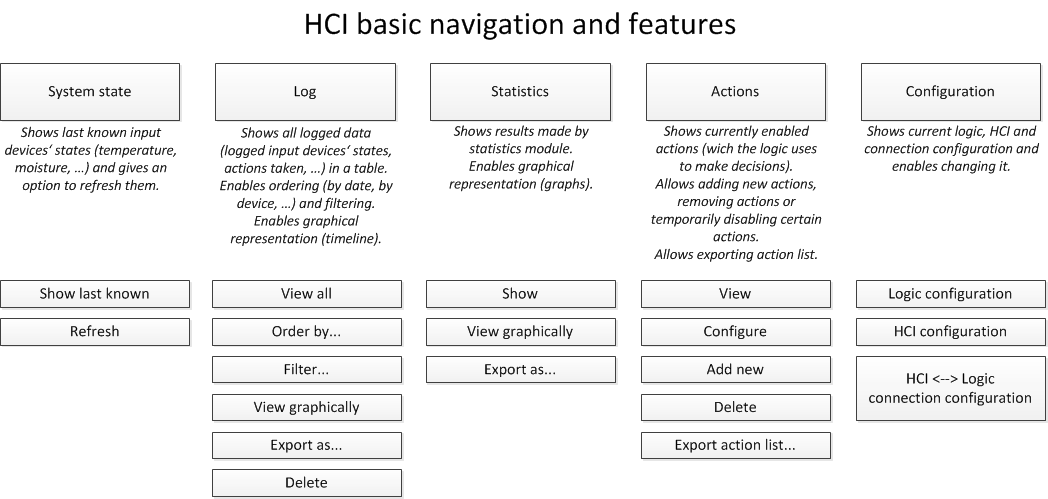Human Computer Interaction¶
- Table of contents
- Human Computer Interaction
1 Basic concept¶
1.1 Hardware¶
The HCI will will be realised as a website. It will run on an Apache Tomcat http server, which will not run on the same device as Eneraptor's logic. Instead it will run on an independent proxy server.

The intended server-side html generating aplication is Tomcat's Jasper, making JSP the intended website programming language.
1.2 HCI features¶
The picture below shows basic HCI features:

2 Communication with other parts¶
2.1 Logged data (instructions for syslog dev)¶
All logged data has to be written in a PostgreSQL database. Database's name must be eneraptor-db. Data must be writen in standard public schema (default).
The database table will exist prior to logging unit's (Janez) first run, so logging unit does not need to create the table. The logging unit must know, how to add a log entry to the database correctly, so that HCI will be able to use this data:
Every new log entry should be added with the following SQL query:
INSERT INTO logged_data(
id, "version", date_recieved, device_id, reported_data)
VALUES (nextval('hibernate_sequence'), 0, now(), 'enterDeviceIdHere', 'enterReportedDataHere');
enterDeviceIdHere and enterReportedDataHere should be replaced with actual data. Logging unit must not change other parts of the SQL query above.
While developing the logging unit (Janez) it may be useful to have a test database like the one HCI will create in the final product. You can create such a database with the following SQL query:
createEneraptorDatabase.backup
2.2 Getting info from the logic unit (instructions for DMS dev)¶
Every time HCI wants to get any information from the logic directly, it establishes a TCP connection (using sockets). The logic unit should use a socket to listen to a port for an incoming connection.
When a connection is established, HCI sends a series of lines that together represent some XML data and waits until the logic unit sends some XML data back. The connection is then closed. The root node of HCI's request will always be:
<hci-request type="...">
...
</hci-request>
The type attribute value may be one of the following: checkConnection, getConfig, setConfig, getActions, setActions, executeAction.
| type | purpose | what HCI expects in the reply |
checkConnection |
a simple echo for testing connectivity | echoed data |
getConfig |
HCI gets current logic's configuration | logic's current configuration |
setConfig |
HCI sends new configuration to the logic unit | confirmation that new config was accepted |
getActions |
HCI gets a list of actions | logic's currently installed actions |
setActions |
HCI sends a new list of actions to the logic unit | confirmation that new actions list was accepted |
executeAction |
HCI demands executing an action instantly | confirmation that the action has been executed |
2.2.1 The checkConnection protocol¶
This performs a simple test to check, if the connection between HCI and the logic unit can be established succesfully.
The check connection request has the following structure:
<hci-request type="checkConnection">
<data>
INTEGER_VALUE
</data>
</hci-request>
Example:
<hci-request type="checkConnection">
<data>
123456
</data>
</hci-request>
Logic's response shoud have the following structure:
<logic-response type="checkConnection">
<data>
INTEGER_VALUE
<data>
</logic-reply>
Example:
<logic-response type="checkConnection">
<data>
123456
<data>
</logic-reply>
The same value of INTEGER_VALUE in the request should be returned in the response.
2.2.2 The getConfig protocol¶
This is used for obtaining current logic configuration. HCI then may change it and send it back using setConfig request.
HCI's request is static:
<hci-request type="getConfig">
</hci-request>
Logic's response should have the following structure:
<logic-response type="getConfig">
<setting id="settingId1">
<label>Setting 1 label</label>
<desc>Setting 1 description</desc>
<type>SETTING_TYPE</type>
<value>SETTING_VAL</value>
</setting>
...
</logic-reply>
SETTING_TYPE may take one of the following values: byte, short, int, bool, string, float, double.
SETTING_VAL must be either a numer (for byte, short, int, float and double types), a string (for string type) or 'true' or 'false' (for bool type).
The setting's id attribute may be anything. HCI doessn't need to know which settings exist in the logic - the configuration form gets generated from this reply.
Example:
<logic-response type="getConfig">
<setting id="loggingOn">
<label>Logging active</label>
<desc>Sets logging on or off</desc>
<type>bool</type>
<value>true</value>
</setting>
<setting id="ignoreAllMeasurements">
<label>Ignore measurements</label>
<desc>Suspends decision making software by ignoring all measurements</desc>
<type>bool</type>
<value>false</value>
</setting>
</logic-reply>
References¶
- Chopra, Vivek, et al., Professional Apache Tomcat 6, Wrox - Wiley, 2007
- Basham, Bryan, et al., Head First Servlets and JSP™, O’Reilly, 2008
Attachments¶
Updated by Aleksander Bešir about 15 years ago · 16 revisions